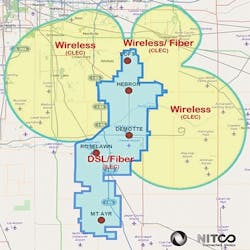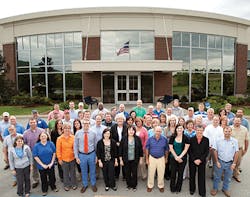Rate/Reach Challenges at the Edge of Suburbia
Part 1 of a 2-part Series
The demand for bandwidth increases every day. We recently saw a refrigerator and an oven that had their own router so they could talk to each other. I personally can’t imagine what a stove and refrigerator have to say to one another, but somebody thinks it is important enough to demand bandwidth for it.
As people migrate from suburbia to the closest rural areas, suburbia becomes ruburbia. That means family-owned independent service providers face the expectation that the stove should be able to talk to the refrigerator. The fact that the customer is 3 miles from the closest loop electronics does not change those expectations whatsoever.
Many independent service providers are meeting high expectations by using innovative strategies that include:
• Fiber-to-the-Home
• Fiber to the Node with shorter copper loops
• Point-to-Point and Line-of-Sight Wireless
• Close Coordination among the customer facing groups
• Targeted training designed to achieve specific goals
Rate/Reach Study
A series of fortunate circumstances have allowed us to study the cultures and procedures of two independent service providers in these new ruburbias. They are doing so well, in fact, that they are poaching customers and employees from their larger neighbor providers.
One of the fortunate circumstances is ISE magazine’s encouragement of this type of objective research. The opportunity to share the results of a pure research study helps our industry grow. Another fortunate circumstance is timing. Two service providers that are already performing well are focused on projects to make themselves get even better and offer even more.
Over the next 8 months, we will examine what is working, and what is not, for 2 similar, but different networks. By using the same "before" and "after" criteria for both companies, trends toward logical conclusions and improvement can be established and shared during our study window.
NITCO of Hebron, Indiana, and RTC of Ringgold, Georgia, are progressive service providers that are performing well in difficult environments. Each organization has strong sales, marketing, logistics, financial, legal, and political teams, and all of those teams contribute to success. However, our study will be completely focused on the Operations groups.
There are plenty of common traits between NITCO and RTC that we have witnessed so far. The most striking common trait is their people believe that tomorrow will be better than today because they know they are trusted to make it happen. When a good idea can become company policy in a week, change can be handled efficiently, and, therefore, their customers don’t feel the growing pains.
Introducing NITCO
On the drive from Chicago, heading to Indianapolis on I-65 South, after the last signs of suburbia, take the first exit and you will be in NITCO’s territory in northwest Indiana. (See Figure 1.) The area is somewhat infamous for being the favorite burial ground for the Capone gang. It is still a quiet area with easy digging, but now major agricultural interests and refugees from the city cohabitate with local people side by side.
Figure 1. NITCO Territory Map
Just riding around the area and looking at their plant will tell you a lot about NITCO. Covers are closed, lashing wire is intact, and no dead drops are hanging from the poles. The little things that mean so much are being focused upon by the management team, and it flows through to the technicians. This is not a shock when you learn that the Director of Operations was mowing the yard of the CO as a high school student.
NITCO is swimming upstream by beginning their IPTV deployment in 2017. I have been involved in IPTV deployment since the San Antonio First Office Application in 2005. I have no doubt that NITCO is facing some serious challenges that have frustrated others. Part of the focus of this study is to determine how NITCO performs with IPTV in the first half of 2017.
NITCO does have some tremendous advantages:
1. They have learned from everybody else’s mistakes.
2. They employ directly everybody that impacts customer service.
3. They are solely focused on the local area.
4. They believe in one another.
5. They have hired young talent and experience away from their larger neighbors.
• They have the wisdom to adopt the good practices.
• They have the flexibility to fix the bad practices.
6. They have hired their own inexperienced talent and are teaching them from the bottom up.
7. They trained everybody directly involved on IPTV services before the first friendly customer was turned up.
8. They are tuning their DSL profiles and copper to reality-based thresholds before they attempt to introduce IPTV.
NITCO goals for July 2017
• Training: "Similar to Cross Training, Cross Knowledge is what we call it. Involving other departments to understand all aspects of service, from Provisioning, Tech Support to Repair."
• Improvement: Improve quality of service all the way to desktop/devices.
• Improvement: Complete the IPTV introduction process to full production before July of 2017.
Key Performance Indicators (KPIs) to be tracked monthly from Q4 of 2016 to the end of Q2 of 2017:
• Report rates, repeated report rates and modems returned for repair before and after cross functional training.
• Report rates, repeated report rates and modems returned for repair before and after the DSL profile improvements.
• Report rates, repeated report rates and modems returned for repair before and after the DSL profile improvements.
• Report rates, repeated report rates and modems returned for repair before and after the focused plant rehab.
For more information on NITCO, please see Figure 3.
Figure 3. Company Detail Matrix
Introducing RTC
About 23 miles from the center of Chattanooga, Tenn., on the way to Atlanta on I-75 South, take the Battlefield Parkway exit and you will be in RTC’s territory in northwest Georgia. If suburbia is beating on the front door in NITCO territory, it is in the living room at RTC. There are significant differences from area to area within their territory, representing a combination of suburban and rural characteristics.
Like everyone else in our industry, RTC wishes that they could wave a magic wand and put every subscriber on fiber optics today. And similar to others, they face the challenge of providing the bandwidth their customers expect by mining every ounce of value that they can from the existing plant. (See Figure 2.)
Figure 2. RTC Employees
RTC plans to install fiber where it makes sense financially. They are utilizing DSL bonding where the outside plant (OSP) can handle it. They plan to shorten the copper loops with new traditional technology (ADSL2+, VDSL2 and Wireless) loop electronics while also investigating the feasibility of G.fast and vectoring.
RTC also has its own advantages:
1. They employ directly everybody that impacts customer service.
2. They employ solutions that fit their own unique environment.
3. Managers are directly involved in day-to-day operations.
4. They have hired talent and experience away from their larger neighbors.
• They have the wisdom to adopt the good practices.
• They have the flexibility to fix the bad practices.
5. They have hired their own inexperienced talent, and are teaching them from the bottom up.
6. Extensive and methodical training as a practice has been in place since 2009.
RTC goals for 2017
• Training: Engage the employees to work with the trainer, drill down to find matters that need tweaking or correcting; can be procedural, or duplication of processes that can be eliminated, etc.
• Improvement: Increase cross-functional performance by utilizing a broad-based troubleshooting strategy.
• Improvement: Reduce overall impulse noise in the OSP network.
• Improvement: Increase delivered subscriber bandwidth in non-fiber areas by 20% overall in the first half of 2017.
RTC Key Performance Indicators (KPIs) to be tracked monthly from Q4 of 2016 to the end of Q2 of 2017:
• Monthly trouble surveys with customers that have reported troubles
• H S I Fiber Install inspections
• H S I Copper Install inspections
• POTS Fiber Install inspections
• POTS Copper Install inspections
• Security Install inspections
• Report rates, repeated report rates, and modems returned for repair before and after cross-functional training.
• Report rates, repeated report rates, and modems returned for repair before and after the focused plant rehab.
For more information on RTC, please see Figure 3.
More to Come
Adjustments and improvement during the study window are an intentional part of the study. Initial results, adjustments and examples will be shared in the July 2017 issue of ISE magazine. Final results, trend analysis, and initial conclusions will be shared during a workshop at ISE EXPO 2017, September, in Orlando, Florida.
[toggle title=”Complicating Factors” load=”hide”]The most striking difference between RTC and NITCO at this time is the crippling draught being experienced in the south. Every signal at every frequency is trying to find a good ground source. Sheath-based impulse noise is making service reliability problematic for RTC. The odds are good that it will eventually rain before this study ends in September 2017, but until then, everything will be harder.
Let’s look at the specifics of one residential case RTC has faced:
• The subscriber was generating 500,000 FECs per minute.
• Errored Seconds and Severely Errored Seconds were happening throughout the day.
• Power Influence fails, but it is single phase distribution power, so not unusual.
• All other copper tests pass.
• Spectral Density shows ADSL2+ noise, but below -80 dBm.
• 0 impulse noise hits at the NID with the drop removed at -45 dBm.
• 350 impulse noise hits per minute toward the drop and cable pair at -45 dBm.
• 50 impulse noise hits per minute toward the drop and cable pair at -35 dBM.
• The cable pair is cut dead beyond the serving terminal.
• Bonds and grounding were repaired at the house beyond.
• 3 hits of impulse noise per minute at -45 dBm (350 before).
• 4,000 FECs (500,000 FECs before).
• 0 errored seconds or severely errored seconds over 24 hours.
Even with the pair cut dead to the field, impulse noise induced onto the sheath further down the cable run was the root cause. Under these conditions, even the bonds that have become just slightly loose due to expansion and contraction will allow impulse noise to find a way to the subscribers. Rain (or really, a better path to ground) will fix many of their current issues. Beyond that, well established bonding and grounding practices are always good ideas. What has been done with the grounding has helped this customer tremendously but the customer is still taking millions of FEC (Forward Error Corrections), so there is still work to be done.
We plan to share more trouble resolution examples in the July 2017 update to this study.[/toggle]
Save
Save
Save
Save
Save
Save









